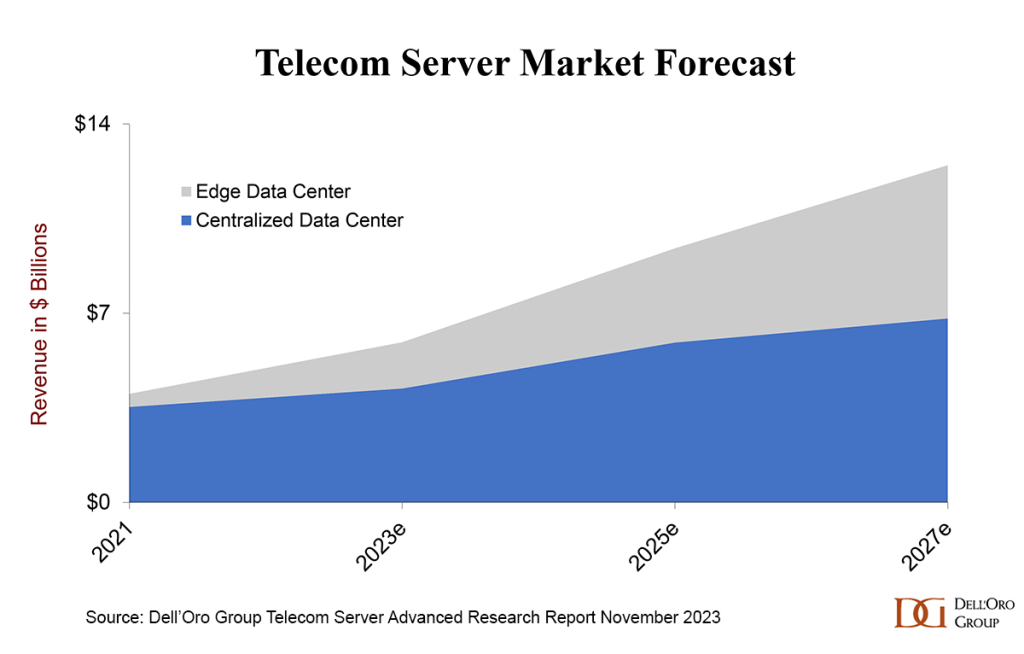REDWOOD CITY, Calif. – November 7, 2023 – Dell’Oro Group, the trusted source for market information about the telecommunications and networking industries, has released an updated report on the Telecom Server market. The report reveals that the market is projected to experience a robust 19% compound annual growth rate (CAGR) over the next five years, fueled by the increasing adoption of Network Function Virtualization (NFV) and the growing momentum of edge use cases.
In the report, Dell’Oro Group draws insights from its comprehensive analysis of various adjacent markets, including 5G Workloads in the Public Cloud, Broadband Access, Data Center IT Capex, Ethernet Switch Campus, Mobile Core Networks, Mobile RAN, Open RAN, and Private Wireless.
We lowered our forecast for the telecom server market relative to the October 2022 report. This is due to a few factors, including economic headwinds leading to reduced spending on mobile network infrastructure, challenges with the adoption of Open RAN and MEC, and a realization that our previous estimates for servers deployed for Operation Support Systems (OSS) and Business Support Systems (BSS) were overstated.
The transition of telecom appliances to server-based architectures is still in its early stages, even when compared to the evolution of cloud computing. We anticipate the telecom server market to experience a 19% five-year CAGR, reaching $12.5 billion by 2027, slightly outpacing the overall data center growth rate of 15%. This adjustment comes as we’ve raised our projections for the data center market, driven by increased investments in accelerated computing for artificial intelligence (AI) applications.
The convergence of data center IT and telecom infrastructure continues, with service providers (SPs) favoring commercial off-the-shelf (COTS) servers for Network Function Virtualization (NFV) to reduce costs, replacing dedicated hardware. Recent supply chain disruptions have highlighted a preference for standardized, commoditized servers over specialized equipment, enabling broader applications through virtualization.
As telecom embraces open network architectures and the edge gains momentum, the competitive server market is poised for growth. The edge, projected to represent 45% of telecom server revenue by 2027, promises resilience, efficiency, and immersive experiences, prompting vendors to compete for dominance in this evolving landscape.
Additional highlights from the November 2023 Telecom Server Forecast include:
- Centralized data center use cases, encompassing MCN and other internal IT workloads, are expected to grow at an 11% CAGR in revenue from 2022 to 2027, while edge data center cases, covering MEC, RAN, and Broadband Access, are anticipated to grow by 38% during the same period.
- Server revenue for edge data centers is expected to achieve a significantly higher growth rate compared to that of centralized data centers for telecom applications. We anticipate changes in the ecosystem as telecom edge infrastructure adoption increases. Servers in centralized data centers for telecom applications will resemble those from traditional IT vendors like Dell, HPE, and Lenovo. In contrast, we anticipate a wider range of solutions from both server and telecom equipment vendors for edge data centers. These systems will be designed to handle harsh environmental conditions and security challenges in remote areas.
- We anticipate the implementation of AI at both the network core and edge. At the core, AI engines could be utilized to automate real-time and near-real-time decision-making based on raw data from internet traffic and allocate network resources in real-time dynamically. At the edge, new AI use cases, primarily related to computer vision, that could enable applications such as industrial automation, autonomous driving, security, and various consumer services.
About the Report:
Dell’Oro Group’s Telecom Server Advanced Research Report offers a comprehensive forecast for service providers and enterprises by region and by technology, examining core vs. edge deployment, MEC opportunities, virtualization of telecom workloads on COTS servers, investment sources, and network technologies connecting edge infrastructure.
